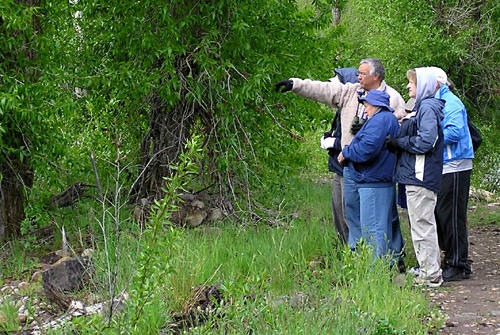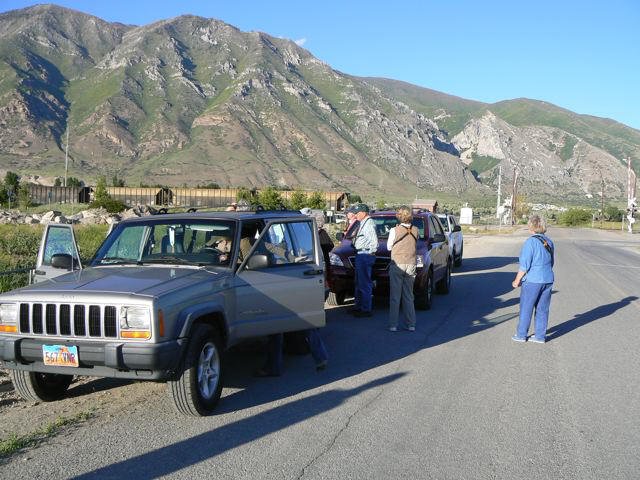Utah County Birders Newsletter
|
 |
|
Albion Basin - photo by Merrill Webb |
Merrill's Musings
By Merrill Webb
ABA Convention
By
now most of you have heard of the recent ABA convention. Birders from all over
the country (and even some from foreign countries) converged on Snowbird to be
educated at some excellent workshops, entertained by some talented musicians,
treated to some of Utah's beautiful scenery, and for easterners, the chance to
see some birds that we take for granted here.
Monday evening's program was provided by a group called "Migratin' Raptors
String Band from HawkWatch International, a talented foursome who educated us
about what constitutes a raptor and what raptors do. The program Friday evening
was titled "Letters from Eden" and featured Julie Zickefoose, a talented writer,
artist and musician. Before Julie's presentation Kenn Kaufman was presented with
the Roger Tory Peterson award for his outstanding contribution to the birding
community. Not only has he published field guides for bird and butterfly
identification, but they have been published in Spanish as well.
Varied workshops addressed such topics as "The Origin of Bird Names",
"Identification of Western Hawks", "Hands-On-Digiscoping", Ted Floyd's "Top Ten
Birds", and "Writing a Good Sighting Report", moderated by Ted Floyd.
Fieldtrips went to Deseret Ranch, Bear River Bird Refuge, southern Utah County,
Antelope Island, Jordanelle State Park, Mirror Lake, Bridal Veil Falls and
Brighton. I don't know who all the leaders were for each of those trips, but
Dennis Shirley led the one to Utah County, Lu Giddings led the one to Mirror
Lake, and I led the one starting at Bridal Veil Falls and ending at Sundance.
Not just once, but three times each. Bus loads of people, not just a van load.
The best birds on my trip were the Black Swifts at Bridal Veil Falls and a
nesting Dipper at Vivian Park. You have no doubt seen Dennis's report of his
trips on the internet.
Professional guides were assigned to each local leader, and they were very good.
For example, on the Tuesday and Thursday trips, the guides had located the
swifts at Bridal Veil before I even had my spotting scope set up. They were
really amazing.
I don't know what the final number was for the whole convention, but by Friday,
181 total birds had been seen.
A discount was arranged with Sundance so birders could ride the chairlift. Most
of the people on my trips took advantage of it and were thoroughly impressed
with the beauty of the surrounding mountains, especially Mount Timpanogos. It
also provided a relaxing time and a cooling down time from the heat in the lower
elevations.
My impression of the conference was that it was very well organized. A lot of
people, including Steve Carr, who was the field trip coordinator, spent a lot of
time making sure events ran smoothly. I met a lot of really nice people who
share our love for birds. Plus, I had a chance to impart some of the information
I have learned from doing my research in the Uinta National Forest.
UCB
President, Merrill Webb
 |
|
Ring-necked Pheasant - photo by Eric Huish |
Bird of the Month
Ring-necked Pheasant
Phasianus colchicus
by Lynn Garner
My earliest experiences with birds led me to choose the Ring-necked Pheasant to
feature this month. I was certainly closer to this bird than others; we used
them to supplement our diet any chance we got! Before I tell about that, let’s
talk about the birds.
Pheasants are native to Asia. The species name colchicus comes from the
ancient country of Colchis on the eastern shore of the Black Sea. Greeks
imported pheasants into Europe as early as the time of Alexander the Great. The
fact that pheasants will breed in captivity made pheasant farming possible; many
societies raised pheasants for food over the centuries. Millions of pheasants
have been released into hunting grounds; the pheasant is the most hunted and the
most studied bird of all time.
The Ring-necked Pheasant we all know and love was imported into the U. S. from
about 1800 onward, but successful feral populations did not establish until
about 1857. Multiple introductions have led to many distinct, unconnected
populations throughout the continent from California and British Columbia to New
Jersey and Nova Scotia. Pheasants are established on every continent except
Antarctica. Semi-domesticity has produced upwards of thirty subspecies in the U.
S. alone.
The pheasant is a gallinaceous bird, like a chicken. Some say the Chinese name
for pheasant translates as “mountain chicken.” Pheasants are ground-dwelling
birds that will choose to run if they can stay in cover, rather than fly. They
are very strong flyers for short distances. When flushed, they literally explode
into the air with lots of noise. The typical flight is long and shallow:
acceleration to about 30 miles per hour in a few seconds, then a long glide to
eventual cover on the ground again.
The rooster pheasant is up to 30 inches in length, with a long pointed tail,
rounded wings, and a wingspan of up to 34 inches. He is gorgeously colored, with
a red face, iridescent green head, a white ring around the neck, maroon breast,
orange-brown flanks, and brown barred tail. The longest tail feathers may exceed
18 inches and have been popular hat decorations all over the world. The female
is about 20% smaller and much plainer, mostly cryptic brown overall. The rooster
crows with a loud, harsh “koork-KOK” that can be heard at great distance,
followed by a short flapping of the wings which does not carry nearly as far.
Pheasants inhabit agricultural land, especially that interspersed with grassy
ditches, hedges, marshes, woodland borders, and bushy groves. They scratch and
forage on the ground and eat seeds (especially cultivated grains), grasses,
leaves, roots, wild fruits and nuts, and insects. Pheasant nests are shallow
ground depressions in tall grass, unlined or sparsely lined with vegetation and
occasionally a few breast feathers from the female. Eggs are a uniform
olive-brown, about half the size of chicken eggs; a clutch varies from seven to
fifteen. When chicks hatch, they are open-eyed and able to leave the nest and
feed themselves. In the wild, the life span of males is estimated to be about
ten months and of females, about two years.
Pheasant populations seem to be declining in many parts of the country. Probable
causes include turning farmland into residential areas and changes from small,
multipurpose farms into large acreages specializing in a single crop, greatly
reducing the margins with their cover.
I grew up in farmland in southwestern Idaho where grain and hay were the most
frequent crops. The habit of pheasants to make their nests on the ground in tall
grass resulted in quite a few nests in alfalfa fields; the first cutting of hay
often coincided with the incubation period. Many times the hen would not leave
the nest at all or at the last possible moment, suffering death or serious
injury from the mower blade. The reluctance of the rooster to flush if he
thought he was in cover sometimes resulted in his being injured, too. My
brothers and I carried a .22 rifle with us on the mowing machine to put out of
its misery any bird so injured; it always became part of our next meal!
Uninjured birds were just as tasty, too, if we could bag any; we figured they
were just part of the farmer’s harvest, taken from our own land.
I remember an interesting phenomenon: When a thunderstorm would approach, a
flash of lightening would immediately trigger crowing from all the roosters in
the vicinity!
 |
|
UCB at Jordanelle Wetlands - June 7, 2008 - photo by Eric Huish |
Jodanelle Wetlands - 7 June 2008
by Lu Giddings
Low clouds and new snow in the mountains did little to dampen the enthusiasm of
nine Utah County birders on a rather rainy Saturday morning. Jordanelle wetlands
was lush and green and there were plenty of birds. As the rain stopped and the
sun began to work its way through the clouds bird activity picked up. Notable
observations included:
- numerous gray catbirds, singing loudly - often out in plain sight
- four empid species including at least two willow flycatchers; western wood
peewees were impossible to miss this morning
- five swallow species
- numerous osprey, flying and on nests as we drove through Heber valley
- American dippers were wonderfully cooperative and easy to view as we walked
down the river
- fox sparrows were heard but not seen in the wetlands, as were house wrens
Trip participants:
Bart and Yvonne Carter
Eric Huish
LeIla Ogden
Robert Parsons (Jr.) and his sons Daniel and Andrew
Bonnie Williams
Thanks to all those who rolled out of bed on a wet Saturday morning to support
this activity!
Lu Giddings
partial trip list (seen by most participants) - 45 species
Canada Goose, Mallard, Cinnamon Teal, Great Blue Heron, Turkey Vulture, Osprey,
Red-tailed Hawk, American Kestrel, Sandhill Crane, Killdeer, Spotted Sandpiper,
Mourning Dove, Broad-tailed Hummingbird, Downy Woodpecker, Northern Flicker,
Olive-sided Flycatcher, Western Wood-Pewee, Willow Flycatcher, Dusky Flycatcher,
Warbling Vireo, Black-billed Magpie, Tree Swallow, Violet-green Swallow,
Northern Rough-winged Swallow, Cliff Swallow, Barn Swallow, Black-capped
Chickadee, House Wren, American Dipper, American Robin, Gray Catbird, Cedar
Waxwing, Yellow Warbler, Common Yellowthroat, Western Tanager, Fox Sparrow, Song
Sparrow, Black-headed Grosbeak, Red-winged Blackbird, Yellow-headed Blackbird,
Brown-headed Cowbird, Bullock's Oriole, House Finch, Pine Siskin, American
Goldfinch.
 |
|
Birding the fields near East Bay - June 11, 2008 - photo by Lynn Garner |
East Bay and Rehabilitating Wildlife -
11 June 2008
by Eric Huish
This month's meeting was again replaced with an evening field trip, this time
led by Tuula Rose, and again we had a great turnout. We started by birding the
East Bay ponds then wondered/birded our way over to Patty Richards place in
Palmyra to get a tour of her Wildlife Rehabilitation facilities. We were treated
to close up views of, and information about, various raptors and owls. My
personal favorites were the Swainson's Hawk, Peregrine Falcons, Ring-tailed Cat
(not a bird but a skinny raccoon-like mammal), Great Horned, Barn, Western
Screech and Flammulated Owls (Wow, Flammulateds are small). It was a very
enjoyable evening.
Birders Driving Drowsy
by Alton Thygerson
Would you ride with a drunk driver? The answer should be obvious. Would you ride
with a driver who feels sleepy? Your answer should be the same as the one you
gave for the drinking driver—you would not. The science is in—drowsy driving is
as dangerous as driving drunk.
When you hear about a single car rollover, it may be about a drowsy driver
falling asleep at the wheel. I suspect that this may have been the case of a
well known Utah birder who sustained disabling injuries a year or so ago.
Many birders have ridden at one time or another with a drowsy driver. Remember
the times while on a birding trip and you were a passenger and felt sleepy or
even dozed off? If you were feeling that way, perhaps the driver was too.
How many times while on a birding trip have you seen a driver voluntarily
relinquish his position to a passenger to drive because of sleepiness? In all of
my many birding trips, I’ve seen it once.
I am probably as guilty of drowsy driving as many others. My latest drowsy
driving incident occurred during a birding trip to Wayne and Garfield counties.
Outside of the small town of Enterprise, I told my wife that I needed to pull
over and take a nap. While she could have driven, I would have missed several
good birding spots. So, we found shade under a large tree in an LDS chapel
parking lot, and we both took a 30 minute “power nap” before continuing our
excursion.
Be cautious about using these excuses for continuing to drive while feeling
sleepy:
• I drink caffeine to keep me awake! It will keep you alert for a short time,
but is not the definitive answer to sleepiness. If you are sleepy, you need
sleep. Of course, if you drink a lot of caffeine, you will have more occasions
to stop to empty your bladder which might momentarily keep you awake.
• I stop often and walk around looking for birds! This helps, but the sleepiness
will resume. Even having your head out of the window and having fresh, cool air
blowing on your face does not work.
• Seeing all those birds rejuvenates me! This may help momentarily, and there
can be excitement in the chasing of a particular bird. However, there are many
birding trips within the county or state where all that is seen are the same
birds over and over and in the same places which may become monotonous.
Incidentally, this may be one reason why birders expand their trips to other
parts of the state, country and foreign countries.
• The rumble strips on I-15 keep me alert! True, studies show that highways with
rumble strips have lower single vehicle crash rates. While a lot of birding
involves driving on a freeway to get to birding spots, about the nearest thing
would be the “wash boarding” on some dirt roads.
• Playing loud music helps keep me alert! For awhile perhaps. It also prevents
you from hearing bird vocalizations--a key factor in locating and recognizing
birds.
I love marathon birding! On those long days from early morning and into the
dark, many birds can be found, some of the rarer birds are usually seen, and you
are in good company with fellow birders. However, such events could be marred by
drowsy driving-related crashes and injuries.
Let’s all recognize the hazard of drowsy driving so that none of our birding
community members will be lost or disabled.
Backyard Bird of the
Month
June 2008
Steve Carr - Holladay
Black-headed Grosbeak - 38th year running.
Yvonne Carter - Highland
It's a little quieter right now but still a lot of American Goldfinches
and a male and female Bullock Oriole.
Lynn Garner - Provo
A Lesser Goldfinch flitting from tree to tree.
Eric Huish - Pleasant Grove
Wilson's Warbler
Milt Moody - Provo
A brood of 11 California Quail about 1/3 the size of the adults.
Bruce Robinson - West Jordan
Baby doves, baby robins, baby ...
Tuula Rose - Provo
I looked up to the big box elder in the corner of my yard thinking I saw a
mourning dove sitting on a branch. Double checked with bins, turned out to be a
Common Night Hawk roosting there.
Reed Stone - Provo
Osprey - While sitting on my riverside deck I noticed a brown streak,
from the sky, plunge into the river and disappear. A second later up welled an
unsuccessful diver and flew away.
Bonnie Williams - Mapleton
Olive-sided Flycatcher - In the top of Alona's tree.
We would like you to share your favorite backyard bird each month. Please send
your favorite bird at the end of the month to newsletter@utahbirds.org or call
360-8777.